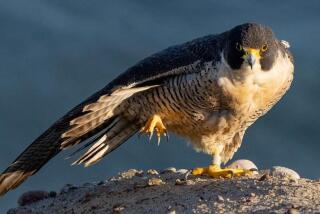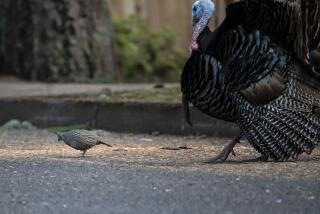A wing and a prayer as Audubon members set out on annual survey
Reporting from New York — Some things are a given when you’re with people who count birds.
First, prepare to be interrupted.
“Chickadee!” someone will shout in the midst of a conversation that has nothing to do with the black-headed little passerine (that’s birders’-speak for a perching species).
FOR THE RECORD:
Bird census: A photo caption that accompanied a Dec. 26 article in Section A about the Audubon Society’s annual Christmas Bird Count misidentified one of two people taking part in the count. In the photo, Eric Addinall is at left and the person at right is Chris Schuster, not Marion Sargeant. —
“Oh! I just heard a yellow-bellied sapsucker!” someone else will blurt out.
“Two red-tails!” another birder will bellow, pointing skyward at a pair of hawks soaring across a slate sky beginning to drop snowflakes on the cusp of a monstrous storm.
Second, prepare to be cold, at least if you are taking part in the New York leg of the National Audubon Society’s Christmas Bird Count, an annual census that gauges bird populations and migratory trends. Conservationists use the information to plan habitat protection and for other efforts.
This year, the count -- taking place in more than 2,000 locales across the Americas from Dec. 14 to Jan. 5 -- has special resonance, given concerns about global warming and the failure of the United Nations conference on climate change to reach a binding deal to reduce emissions blamed for rising temperatures. Glacial melting and rising sea levels, conservationists say, are cutting away at many birds’ habitats, as are deforestation and urbanization.
“We’ve been existing in a warmer climate here in the United States for the past 40 years, and the birds show it,” said Gregory Butcher, Audubon’s director of bird conservation. The evidence, he said, is in the growing numbers of species being found farther north than the warmer locales where their migratory habits once put them.
An Audubon study of 305 species shows that from 1966 to 2006, more than 170 species have moved “significantly further to the north,” Butcher said. “And those were birds of just about every kind.”
Admittedly, it was difficult to focus on global warming when the bird count, which was first held in 1900, came to Brooklyn’s Prospect Park the weekend before Christmas. Temperatures were in the low 20s and gusts whipped off the icy lake as about half a dozen counters from the Brooklyn Bird Club trekked into the park, where more than 200 species can be found at the height of spring migration.
Prospect Park is a migrant-bird magnet -- green space within an urban environment that invites birds to stop over on their travels south. That makes it an ideal spotting ground for bird-watchers like Peter Dorosh, the club president, who marched toward a thicket with his field scope slung over a shoulder, seemingly oblivious to the brutal cold.
Fall had loosened the leaves from most trees, leaving a tangle of bare branches that made it easy to spot the red-tailed hawk perched silently atop a tree and the bright-red cardinals.
“Most of the stuff we get is common, but you always have that joy of discovery, that rare bird,” Dorosh said. His love of bird-watching began at the age of 14, when he glanced out the window of his Brooklyn home to see a scarlet tanager, a brilliant songbird with black wings. “I was smitten,” he said. “I had that epiphany sighting.”
That was more than 30 years ago. Since then, Dorosh has birded in minus-3 temperatures, and on the beach with wind chills that made it feel like minus-30. So the recent chill in Brooklyn may have seemed tame as Dorosh set up his field scope on the edge of the park’s lake and began counting geese. Four mute swans, a coot and some mallards glided silently across the gray water just off the rocky shore.
As Dorosh stared through the scope, other team members branched out onto nearby paths: scouring the trees, cocking their ears and yelling out bird counts, either from sightings or from gauging the birds’ numbers based on their calls.
Brenda Timm tallied the count up on a chart, battling to keep her ungloved fingers from freezing as she flipped through pages and pages of species.
Their cries -- the birders’ that is -- rang out. “Two robins!” “White-breasted nuthatch!” “One chickadee!”
Sandra Paci began bird-watching in the spring of 2003, when she needed a diversion at the start of the Iraq war. “It just seemed so soothing,” she said of the expeditions. Her favorite sighting was a rarely seen ivory gull in New Jersey earlier this year. “I was holding out my arm waiting to get pooped on so I could brag about it,” she said.
Jerry Layton came to birding by way of botany, part of an evolution of interests that includes all other things winged. “That’s a Boeing 757!” he said authoritatively as a jet flew overhead.
Layton’s favorite birding experience was watching two mallards mating in a lake.
“It was the most exciting thing I’ve ever seen. It took all of two seconds,” he said, describing the birds’ courtship ritual of bopping their heads up and down, then the flurry of feathers and the quick splash as the deed was done.
As he spoke, someone else yelled out another sighting. “Blue heron!”
On this day, Dorosh’s team was one of more than a dozen conducting counts in parks, along shorelines and in residential areas across New York City’s five boroughs. Similar counts are taking place from the frozen shores of the Bering Sea in Alaska to the balmy beaches of Guam in the South Pacific, and throughout California. The results will be compiled by the Audubon Society and used by scientists to measure the health of bird populations.
“There is definitely a barometer out there telling us we should be doing something,” said Paul Keim, who was compiling results from the Prospect Park counters at the midway point. He cited the spotting that day of an ovenbird, a Neotropical species that normally would be farther south.
Several hours later, members of all the Brooklyn counting teams gathered at the park’s Audubon center. By then, snow had blanketed the ground outside and wind was blowing the flakes horizontally. Counters with wind-burned faces devoured bowls of stew and plates of cakes and cookies before settling in to hear the numbers.
There were clucks of concern when certain species names were read and team leaders reported sparse sightings -- or none at all. Only one red-necked pheasant was recorded, something birders attributed to growing numbers of feral cats and dogs. Red-throated loons numbered 20, compared with an average of 74 in past counts.
A loud “Oooooooo” of dismay went up when no team could report having seen an American kestrel, a blue-winged bird of prey. In last year’s Christmas count, Brooklyn teams counted four.
“Every year we sit here and say, ‘Gee, they’re going down, one of these years we’re gonna lose them.’ This is the year,” said Rich Cech, who offered a running commentary of the results as he tallied them on a spreadsheet on his laptop. “That sucks,” he said when nobody reported seeing a kingfisher. “That’s amazing!” he exclaimed at the news that 10 killdeer, with their distinct black breast bands, had been counted.
Cech blamed the weather for many lower-than-anticipated numbers. Fierce winds and cold kept many birds out of sight or made it difficult to spot them. But he blamed the kestrel’s decline on habitat loss. The small falcon tends to find havens in urban areas in which to nest, such as trees and rock crevices, but development makes such cavities harder to find.
When the counting was done, the Brooklyn teams had a total of 123 species and 42,942 birds to report. Rare sightings included the ovenbird and a black-throated green warbler, which should have been in warm southern climates by now.
Prospect Park’s team came up with 51 species, the lowest total in years. Last year they spotted 60.
But Dorosh was satisfied that whatever the numbers, they would help tell the bigger story of how birds everywhere are faring.
“I’m not disappointed,” he said. “Nature has her own design, her own intentions.”
More to Read
Sign up for Essential California
The most important California stories and recommendations in your inbox every morning.
You may occasionally receive promotional content from the Los Angeles Times.










